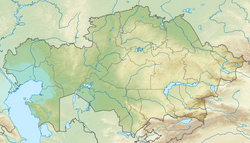| Dabrazhin Formation | |
|---|---|
| Stratigraphic range: Santonian-Campanian ~ | |
| Type | Geological formation |
| Lithology | |
| Primary | Conglomerate |
| Other | Sandstone |
| Location | |
| Coordinates | 41°42′N68°30′E / 41.7°N 68.5°E |
| Approximate paleocoordinates | 35°06′N62°00′E / 35.1°N 62.0°E |
| Region | Ongtüstik Qazaqstan Asht |
| Country | Kazakhstan, Tajikistan |
The Dabrazhin Formation (Russian: Dabrazinskaya Svita) preserves dinosaur fossils in Kazakhstan and Tajikistan. There are indeterminate remains of sauropods, nodosaurs, ornithomimosaurs, and other reptiles.
Contents
The strata date back to the Late Cretaceous. Dinosaur remains are among the fossils that have been recovered from the formation. [1]
